 IST,
IST,
I. The Real Economy
The robust performance of the Indian economy continued during the second quarter (July-September) of 2005-06. According to the Central Statistical Organisation (CSO), the economy recorded a real GDP growth of 8.0 per cent in the second quarter of 2005-06 maintaining the momentum of growth in the first quarter, and notably higher than that of 6.7 per cent a year ago (Chart 1). Although there was some loss of pace in manufacturing activity during the second quarter from the double-digit growth of the first quarter, it was more or less offset by a stronger growth in the services sector, especially the sub-sector ‘financing, insurance, real estate and business services’. Real GDP originating from the ‘agricultural and allied activities’ benefited from the positive impact of the near normal South-West monsoon. Overall, the economy thus recorded a real GDP growth of 8.1 per cent in the first half of 2005-06, one percentage point higher than a year ago (Table 1).
Against the backdrop of the overall performance of the Indian economy in the first half of 2005-06, this Section presents developments in the Indian economy during 2005-06 so far covering the agricultural sector, industrial production, business and investment expectations and the lead indicators of service sector activity.
Agricultural Situation
The progress of the South-West monsoon season (June-September) 2005 was satisfactory. Although the monsoon was initially weak - till June 22, 2005,
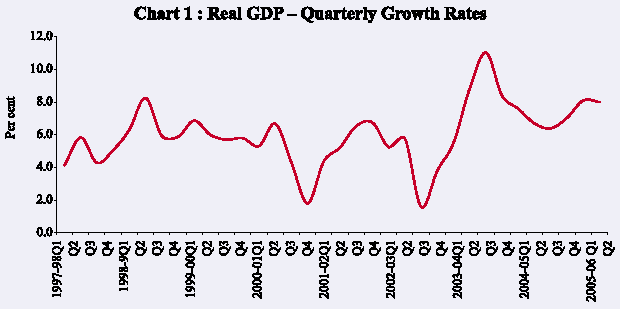
|
Table 1: Growth Rates of Real GDP |
|||||||||||||
|
Sector |
1993-94 |
2003- |
2004- |
2004-05 |
2005-06 |
2004- |
2005- |
||||||
|
to |
04* |
05# |
05 |
06 |
|||||||||
|
Q1 |
Q2 |
Q3 |
Q4 |
Q1 |
Q2 |
||||||||
|
2002-03 |
|||||||||||||
|
H1 |
H1 |
||||||||||||
|
(Average) |
|||||||||||||
|
1 |
2 |
3 |
4 |
5 |
6 |
7 |
8 |
9 |
10 |
11 |
12 |
||
|
1. |
Agriculture and Allied |
||||||||||||
|
Activities |
2.1 |
9.6 |
1.1 |
3.8 |
0.0 |
-0.5 |
1.8 |
2.0 |
2.0 |
2.1 |
2.0 |
||
|
(26.5) |
(21.7) |
(20.5) |
|||||||||||
|
1.1 |
Agriculture |
2.0 |
10.3 |
N.A |
|||||||||
|
2. |
Industry |
6.6 |
6.5 |
8.3 |
7.6 |
9.1 |
9.2 |
7.3 |
10.1 |
7.6 |
8.3 |
8.8 |
|
|
(22.1) |
(21.6) |
(21.9) |
|||||||||||
|
2.1 |
Mining and Quarrying |
4.7 |
6.4 |
4.5 |
6.9 |
4.7 |
4.5 |
2.5 |
3.2 |
-1.1 |
5.8 |
1.1 |
|
|
2.2 |
Manufacturing |
7.1 |
6.9 |
9.2 |
7.9 |
9.6 |
10.5 |
8.6 |
11.3 |
9.2 |
8.8 |
10.2 |
|
|
2.3 |
Electricity, Gas and |
||||||||||||
|
Water Supply |
5.2 |
3.7 |
5.5 |
6.1 |
9.1 |
4.4 |
2.6 |
7.9 |
3.3 |
7.6 |
5.6 |
||
|
3. |
Services |
7.8 |
8.9 |
8.6 |
9.1 |
7.7 |
8.8 |
8.8 |
9.6 |
9.8 |
8.4 |
9.7 |
|
|
(51.4) |
(56.7) |
(57.6) |
|||||||||||
|
3.1 |
Trade, Hotels, |
||||||||||||
|
Restaurants, |
|||||||||||||
|
Transport, Storage and |
|||||||||||||
|
Communication |
8.8 |
11.8 |
11.4 |
11.5 |
12.3 |
10.8 |
11.1 |
12.4 |
12.0 |
11.9 |
12.2 |
||
|
3.2 |
Financing, Insurance, |
||||||||||||
|
Real Estate and |
|||||||||||||
|
Business Services |
8.0 |
7.1 |
7.1 |
7.0 |
5.5 |
8.2 |
7.7 |
8.3 |
9.9 |
6.2 |
9.1 |
||
|
3.3 |
Community, Social |
||||||||||||
|
and Personal services |
6.9 |
5.8 |
5.9 |
8.2 |
3.0 |
5.6 |
7.2 |
6.1 |
6.7 |
5.4 |
6.4 |
||
|
3.4 |
Construction |
5.7 |
7.0 |
5.2 |
5.0 |
4.6 |
7.2 |
4.1 |
7.9 |
7.4 |
4.8 |
7.6 |
|
|
4. Real GDP at Factor Cost |
6.0 |
8.5 |
6.9 |
7.6 |
6.7 |
6.4 |
7.0 |
8.1 |
8.0 |
7.1 |
8.1 |
||
|
(100) |
(100) |
(100) |
|||||||||||
|
* : Quick Estimates. |
|||||||||||||
the cumulative rainfall was 49 per cent below normal – it picked up in the subsequent period and the cumulative rainfall recorded during the season was only one per cent below normal as compared with 13 per cent below normal during the previous year. Of the 36 meteorological sub-divisions, cumulative rainfall was excess/normal in 32 sub-divisions (23 sub-divisions during last year) and deficient in 4 sub-divisions (13 sub divisions). At the district level, 72 percent of the total number of districts received excess/normal rainfall, while the rest received deficient rain.
The cumulative rainfall during the North-East Monsoon season (October 1 to December 31, 2005) was 10 per cent above normal as compared with 11 per cent below normal during the corresponding period of the previous year although the distribution of the rainfall was skewed (Chart 2). The total live water storage
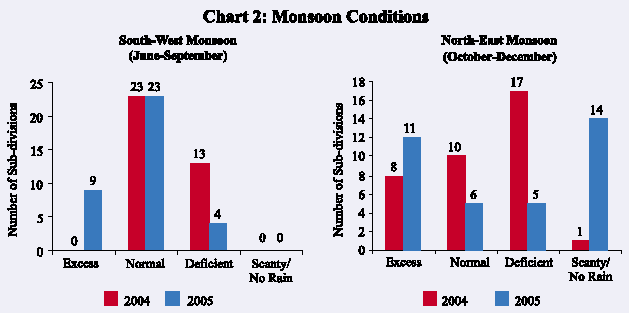
as on January 6, 2005 in the 76 major reservoirs1 monitored by the Central Water Commission improved to 65 per cent of the Full Reservoir Level (FRL) from 45 per cent a year ago.
A satisfactory monsoon during 2005-06 coupled with adequate water reservoir levels have facilitated improved area coverage under both kharif and rabi crops. The area under kharif crops was 1.2 per cent higher than a year ago, led by increased area under rice, maize, pulses and sugarcane. As regards rabi crops, the area coverage as on January 2, 2006 was 1.5 per cent higher than a year ago on account of increased coverage in respect of major crops such as wheat and rapeseed (Table 2).
Agricultural production estimates are available for the kharif crop. According to the First Advance Estimates released by the Ministry of Agriculture on September 19, 2005, total kharif foodgrains production during 2005-06 at 105.3 million tonnes will be marginally higher (1.9 per cent) than last year but notably lower than that achieved in 2003-04 (Tables 3 and 4). The increase in the foodgrains production is expected to emanate mainly from higher output of rice, maize and pulses. Among the commercial crops, the output of cotton, oilseeds and jute is estimated to decline while that of sugarcane and mesta is expected to show an improvement.
Food Management
The total procurement of rice and wheat during 2005-06 (up to January 3, 2006) at 33.7 million tonnes was 1.6 per cent lower than that in the
1 These reservoirs account for 63 per cent of the total reservoir capacity of the country.
|
Table 2: Progress of Area under Crops - 2005-06 |
||||
|
(Million Hectares) |
||||
|
Crop |
Normal Area |
Area Coverage |
||
|
2004 |
2005 |
Variation |
||
|
(2005 over 2004) |
||||
|
(Per cent) |
||||
|
1 |
2 |
3 |
4 |
5 |
|
Kharif Crops |
||||
|
Rice |
39.9 |
35.5 |
37.1 |
4.6 |
|
Coarse Cereals |
22.9 |
22.5 |
21.9 |
-2.5 |
|
Of which |
||||
|
Bajra |
9.3 |
9.1 |
8.2 |
-9.4 |
|
Jowar |
4.6 |
3.9 |
3.8 |
-3.3 |
|
Maize |
6.0 |
7.0 |
7.3 |
5.2 |
|
Pulses |
10.6 |
11.2 |
11.4 |
1.4 |
|
Oilseeds |
15.1 |
18.0 |
17.6 |
-2.6 |
|
Of which |
||||
|
Groundnut |
5.5 |
5.8 |
5.6 |
-3.1 |
|
Soyabean |
6.3 |
8.0 |
7.7 |
-3.1 |
|
Sesamum |
1.6 |
2.0 |
1.9 |
-6.4 |
|
Niger |
0.5 |
0.5 |
0.4 |
-23.2 |
|
Cotton |
8.3 |
8.6 |
8.6 |
0.0 |
|
Sugarcane |
4.3 |
3.8 |
4.1 |
10.3 |
|
All Crops |
101.9 |
100.4 |
101.6 |
1.2 |
|
Rabi Crops (As on January 2, 2005) |
||||
|
Wheat |
26.3 |
24.1 |
24.3 |
0.9 |
|
Rice |
3.8 |
0.8 |
0.8 |
4.3 |
|
Coarse Cereals |
6.5 |
6.8 |
6.8 |
-0.1 |
|
Of which |
||||
|
Jowar |
5.1 |
5.2 |
5.1 |
-2.5 |
|
Maize |
0.7 |
0.7 |
0.7 |
-0.8 |
|
Barley |
0.7 |
0.8 |
0.8 |
1.8 |
|
Oilseeds |
7.8 |
9.6 |
9.9 |
3.4 |
|
Of which |
||||
|
Rapeseed |
5.1 |
6.7 |
7.2 |
6.8 |
|
Groundnut |
0.8 |
0.5 |
0.4 |
-15.8 |
|
Sunflower |
1.0 |
1.2 |
1.2 |
1.4 |
|
Sesamum |
0.2 |
0.1 |
0.1 |
13.6 |
|
Linseed |
0.5 |
0.6 |
0.6 |
0.5 |
|
All Crops |
55.5 |
53.1 |
53.9 |
1.5 |
|
Source: Ministry of Agriculture, Government of India. |
||||
corresponding period of the previous year. The total off-take of foodgrains (rice and wheat) during 2005-06 (up to October 31, 2005) at 23.4 million tonnes was marginally higher by 0.2 per cent over the corresponding period of the preceding year, mainly due to a rise in the off-take under the Targeted Public Distribution System (TPDS) and the other welfare schemes (OWS) (Table 5). Reflecting the lower procurement, the total stocks of foodgrains with the Food Corporation of India (FCI) and the State agencies stood at around 19.8
|
Table 3: Kharif Production: 2005-06 |
|||||
|
(Million Tonnes) |
|||||
|
Crops |
2004-05* |
2005-06** |
Variation |
||
|
(Per cent) |
|||||
|
1 |
2 |
3 |
4 |
||
|
Total Foodgrains |
103.3 |
105.3 |
1.9 |
||
|
Rice |
71.7 |
73.8 |
3.0 |
||
|
Coarse Cereals |
26.7 |
26.4 |
-1.0 |
||
|
Bajra |
8.1 |
7.8 |
-3.9 |
||
|
Jowar |
4.0 |
3.9 |
-3.5 |
||
|
Maize |
11.6 |
12.2 |
4.9 |
||
|
Total Pulses |
5.0 |
5.0 |
0.6 |
||
|
Tur |
2.6 |
2.3 |
-10.5 |
||
|
Other Kharif Pulses |
2.4 |
2.7 |
12.6 |
||
|
Total Oilseeds |
14.9 |
14.6 |
-2.5 |
||
|
Groundnut |
5.3 |
5.9 |
11.4 |
||
|
Soyabean |
7.5 |
6.6 |
-12.4 |
||
|
Cotton# |
17.0 |
15.9 |
-6.5 |
||
|
Jute@ |
9.6 |
9.2 |
-4.3 |
||
|
Mesta@ |
0.9 |
0.9 |
1.2 |
||
|
Sugarcane |
232.3 |
257.7 |
10.9 |
||
|
# : Million bales of 170 kgs. each. |
|||||
million tonnes as on November 1, 2005, about 16.5 per cent lower than a year ago. The stocks, however, remained higher than the buffer stock norms (16.2 million tonnes). The decline in stocks was mainly on account of wheat stocks
|
Table 4: Agricultural Production |
|||||||
|
(Million Tonnes) |
|||||||
|
Crop |
2003-04 |
2004-05 |
|||||
|
T |
A |
T |
A $ |
||||
|
1 |
2 |
3 |
5 |
6 |
|||
|
Rice |
93.0 |
88.3 |
93.5 |
85.3 |
|||
|
Wheat |
78.0 |
72.1 |
79.5 |
72.0 |
|||
|
Coarse Cereals |
34.0 |
38.1 |
36.8 |
33.9 |
|||
|
Pulses |
15.0 |
14.9 |
15.3 |
13.4 |
|||
|
Total Foodgrains |
220.0 |
213.5 |
225.1 |
204.6 |
|||
|
Kharif |
111.7 |
116.9 |
113.8 |
103.3 |
|||
|
Rabi |
108.3 |
96.6 |
111.3 |
101.3 |
|||
|
Total Oilseeds |
24.7 |
25.3 |
26.2 |
26.1 |
|||
|
Kharif |
14.7 |
16.8 |
16.3 |
14.9 |
|||
|
Rabi |
10.7 |
8.5 |
9.9 |
11.2 |
|||
|
Cotton # |
15.0 |
13.9 |
15.0 |
17.0 |
|||
|
Jute and Mesta ## |
12.0 |
11.2 |
11.8 |
10.5 |
|||
|
Sugarcane |
320.0 |
237.3 |
270.0 |
232.3 |
|||
|
T : Target |
|||||||
|
Table 5: Management of Food Stocks |
|||||||||||||
|
(Million Tonnes) |
|||||||||||||
|
Opening Stock of |
Procurement of |
Foodgrains off-take |
Closing |
Norms |
|||||||||
|
Foodgrains |
Foodgrains |
Stock |
|||||||||||
|
Month |
Rice |
Wheat |
Total |
Rice |
Wheat |
Total |
PDS |
OWS |
OMS - |
Exports |
|||
|
Domestic |
|||||||||||||
|
1 |
2 |
3 |
4 |
5 |
6 |
7 |
8 |
9 |
10 |
11 |
12 |
13 |
|
|
2004 |
|||||||||||||
|
April |
13.1 |
6.9 |
20.6 |
1.2 |
14.5 |
15.7 |
2.0 |
0.5 |
0.0 |
0.3 |
32.4 |
15.8 |
|
|
May |
12.7 |
19.0 |
32.4 |
1.3 |
1.7 |
3.0 |
2.3 |
0.6 |
0.0 |
0.1 |
32.3 |
||
|
June |
12.3 |
19.4 |
32.3 |
0.9 |
0.5 |
1.4 |
2.3 |
1.0 |
0.0 |
0.1 |
30.6 |
||
|
July |
10.8 |
19.2 |
30.6 |
0.4 |
0.1 |
0.5 |
2.4 |
1.0 |
0.0 |
0.1 |
27.2 |
24.3 |
|
|
August |
9.1 |
17.4 |
27.2 |
0.5 |
0.0 |
0.5 |
2.4 |
1.0 |
0.0 |
0.1 |
23.0 |
||
|
September |
7.1 |
15.8 |
23.0 |
0.2 |
0.0 |
0.2 |
2.5 |
1.0 |
0.0 |
0.1 |
20.3 |
||
|
October |
6.1 |
14.2 |
20.3 |
7.4 |
0.0 |
7.4 |
2.4 |
0.8 |
0.0 |
0.0 |
23.7 |
18.1 |
|
|
November |
11.0 |
12.6 |
23.7 |
1.9 |
0.0 |
1.9 |
2.4 |
0.6 |
0.0 |
0.0 |
21.8 |
||
|
December |
11.1 |
10.7 |
21.8 |
3.2 |
0.0 |
3.2 |
2.6 |
0.7 |
0.0 |
0.0 |
21.7 |
||
|
2005 |
|||||||||||||
|
January |
12.8 |
8.9 |
21.7 |
3.9 |
0.0 |
3.9 |
2.7 |
0.8 |
0.0 |
0.0 |
21.5 |
16.8 |
|
|
February |
14.2 |
7.3 |
21.5 |
2.3 |
0.0 |
2.3 |
2.7 |
0.9 |
0.0 |
0.0 |
20.0 |
||
|
March |
13.7 |
5.8 |
20.0 |
1.7 |
0.0 |
1.7 |
2.7 |
1.7 |
0.0 |
0.0 |
18.0 |
||
|
April |
13.3 |
4.1 |
18.0 |
1.2 |
12.8 |
14.0 |
2.4 |
0.8 |
0.0 |
0.0 |
28.5 |
16.2 |
|
|
May |
13.0 |
15.1 |
28.5 |
1.2 |
2.0 |
3.1 |
2.5 |
0.8 |
0.0 |
0.0 |
27.9 |
||
|
June |
11.6 |
15.7 |
27.9 |
0.8 |
0.1 |
0.9 |
2.5 |
1.5 |
.0.0 |
0.0 |
25.1 |
||
|
July |
10.1 |
14.5 |
25.1 |
0.4 |
0.0 |
0.4 |
2.7 |
0.8 |
0.1 |
0.0 |
21.4 |
26.9 |
|
|
August |
8.0 |
13.0 |
21.4 |
0.9 |
0.0 |
0.9 |
2.5 |
0.8 |
0.1 |
0.0 |
18.4 |
||
|
September |
6.4 |
11.6 |
18.4 |
0.4 |
0.0 |
0.4 |
2.6 |
0.7 |
0.1 |
0.0 |
15.6 |
||
|
October |
4.8 |
10.3 |
15.5 |
7.6 |
0.0 |
7.6 |
2.2 |
0.5 |
0.0 |
0.0 |
19.8 |
16.2 |
|
|
November |
10.3 |
9.1 |
19.8 |
2.7 |
0.0 |
2.7 |
N.A. |
N.A. |
N.A. |
N.A. |
N.A. |
||
|
December |
N.A. |
N.A. |
N.A. |
3.4 |
0.0 |
3.4 |
N.A. |
N.A. |
N.A. |
N.A. |
N.A. |
||
|
January* |
N.A. |
N.A. |
N.A. |
0.4 |
0.0 |
0.4 |
N.A. |
N.A. |
N.A. |
N.A. |
N.A. |
||
|
PDS : Public Distribution System. |
|||||||||||||
which fell by 28.3 per cent from a year ago levels due to lower procurement. Wheat stocks as on November 1, 2005 were 9.1 million tonnes as compared with the buffer stock norms of 11.0 million tonnes.
Industrial Performance
Manufacturing activity witnessed a strong performance during April-November 2005. Although there was some loss of momentum in July 2005, the cumulative growth during the first eight months at 9.4 per cent was higher than a year ago (9.1 per cent). The mining and electricity sectors, on the other hand, recorded a deceleration. The sharp slowdown in the mining sector may be
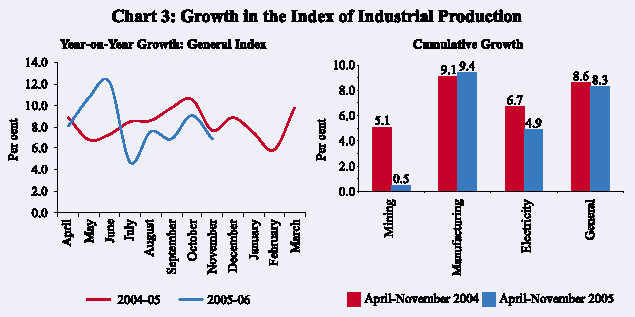
attributable in part to a decline in production of crude oil caused by the break-out of fire in the Mumbai-High oil field in July 2005 and the adverse impact of heavy rainfall on coal mining activities. Lower growth in the electricity sector is attributable to shortage of coal and gas. On the whole, industrial production recorded a growth of 8.3 per cent during April-November 2005 on top of 8.6 per cent in the corresponding period of the preceding year (Chart 3).
Manufacturing activity was broad-based. According to the use-based classification, all major industry groups, except intermediate goods, recorded an acceleration during April-November 2005 (Chart 4). Capital goods recorded
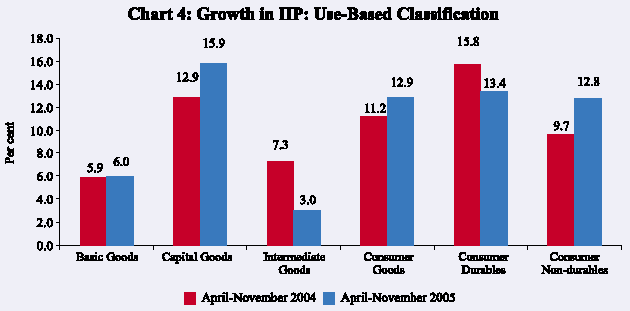
a robust growth of 15.9 per cent - the highest growth during April-November period since 1996-97 (16.5 per cent) - on the back of strong investment demand in the economy. Higher production of textile machinery, industrial machinery, turbines, ship building and repair, material handling equipment, laboratory and scientific instruments, dumpers and boilers propped up the capital goods sector. Consumer goods also recorded a double-digit growth and contributed 48.0 per cent to the overall IIP growth during April-November 2005. While consumer durables sector maintained its high growth, the non-durables segment accelerated due to sugar, milk powder, cotton hosiery cloth, beverages, tobacco and related products. Basic goods recorded a moderate pick-up benefiting from cement, carbon steel, soda ash, caustic soda, salt, sponge iron, aluminium extrusions and aluminium ingots. Intermediate goods sector, however, witnessed a subdued performance largely on account of a slack in petrochemical products, wood and wood products, textile yarns and fibres, finished leather, metal products and parts.
At the two-digit level manufacturing, 13 out of 17 industry groups recorded a positive growth during April-November 2005. Nine industry groups recorded an accelerated growth as compared with eight industry groups in the corresponding period of the previous year. The group ‘other manufacturing industries’ recorded the highest growth of 23.3 per cent during April-November 2005 followed by textile products (including wearing apparel) at 21.6 per cent (Table 6).
|
Table 6: Growth Performance of Manufacturing Industry Groups: April-November 2005 |
|||||
|
Acceleration in Growth |
Deceleration in Growth |
Negative Growth |
|||
|
1. |
Other manufacturing |
1. |
Chemicals and chemical |
1. |
Wool, silk and man-made |
|
industries (23.3) |
products (12.0) |
fibre textiles (-1.0) |
|||
|
2. |
Textile products |
2. |
Machinery and equipment other |
2. |
Metal products and parts |
|
(including wearing |
than transport equipment (10.1) |
(except machinery and |
|||
|
apparels) (21.6) |
equipment) (-2.1) |
||||
|
3. |
Beverages, tobacco and |
3. |
Rubber, plastic, petroleum and |
3. |
Wood and wood products, |
|
related products (17.0) |
coal products (2.7) |
furniture and fixtures (-3.5) |
|||
|
4. |
Basic metal and alloy |
4. |
Leather and leather and |
4. |
Food products (-4.3) |
|
industries (15.3) |
fur products (1.4) |
||||
|
5. |
Transport equipment and |
||||
|
parts (12.5) |
|||||
|
6. |
Cotton textiles (11.7) |
||||
|
7. |
Non-metallic mineral |
||||
|
products (8.2) |
|||||
|
8. |
Paper and paper products (5.8) |
||||
|
9. |
Jute and other vegetable |
||||
|
fibre textiles (2.6) |
|||||
|
Note: Figures in parentheses are growth rates during April-November, 2005. |
|||||
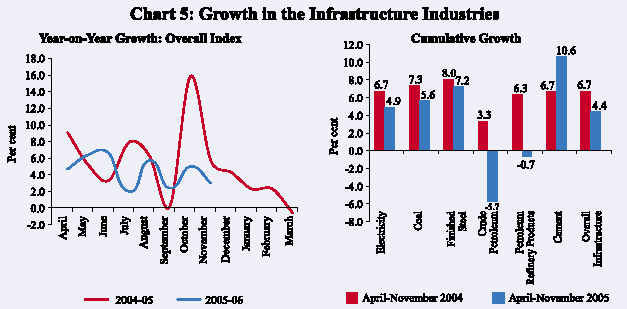
Infrastructure
During April-November 2005, the infrastructure sector continued to remain subdued on account of a decline in crude petroleum and petroleum refinery products as well as a deceleration in growth in other infrastructure industries barring cement (Chart 5). Cement production benefited from the strong growth in domestic demand as well as high exports. Steel production was upheld by domestic demand, although growth was slightly lower than that recorded in last year. Heavy rainfall during the monsoon season pulled down growth in the coal sector. Growth in the electricity sector decelerated on account of inadequate availability of coal and gas. Crude oil recorded negative growth on account of disruption in production activity owing to break-out of fire in Mumbai High oilfield on July 27, 2005.
Business Expectations Surveys
Business expectation surveys suggest that the current phase of industrial activity is likely to continue in the near future (Table 7). FICCI’s latest business
|
Table 7: Business Expectations Surveys |
|||
|
Agency |
Business Expectations |
Growth over |
|
|
previous round |
|||
|
Expectation for |
Index |
||
|
(Per cent) |
|||
|
1 |
2 |
3 |
4 |
|
Dun & Bradstreet |
October-December 2005 |
Business Optimism Index |
7.1 |
|
NCAER |
October 2005-March 2006 |
Business Confidence Index |
1.3 |
|
FICCI |
October 2005-March 2006 |
Business Confidence Index |
2.3 |
|
CII |
September 2005-March 2006 |
Business Confidence Index |
1.5 |
|
RBI |
January-March 2006 |
Business Expectations Index |
2.4 |
confidence survey indicates that industrial activity is expected to record a strong growth in the remaining part of the fiscal year. According to the survey, 70 per cent of the respondents reported capacity utilisation of over 75 per cent reflecting strong demand conditions in the economy. Demand conditions are expected to further strengthen with 83 per cent of the respondents expecting ‘higher to much higher sales’ and 51 per cent of respondents expecting ‘higher to much higher investment’. 34 per cent of the participating companies are planning to add to their workforce. Rising cost of raw materials was, however, viewed as a constraint by a majority (76 per cent) of the respondents and 29 per cent respondents foresaw an increase in their selling prices over the next six months. Similar findings emerge from the latest survey of the Confederation of Indian Industry (CII). The survey results for the second half of 2005-06 show that: (i) 80 per cent of the respondents plan to increase investment; (ii) 60 per cent expect capacity utilisation to be up to 100 per cent and another 19 per cent expect capacity utilisation to exceed 100 per cent; and (iii) 84 per cent expect employment to increase. According to the survey, the confidence index was significantly higher for non-manufacturing firms compared to the manufacturing firms.
According to the Reserve Bank’s latest Industrial Outlook Survey, the Business Expectations Index for January-March 2006 quarter increased by 2.4 per cent over the previous quarter (Chart 6). The expectations index based on the assessment for October-December 2005 was robust showing a rise of 8.2 per cent over the previous quarter, the highest since the inception of the survey.
Survey results indicate that employment, selling prices, imports and profit margins are expected to improve during the quarter January-March 2006 vis-à-vis October-December 2005. On the other hand, the overall business situation,
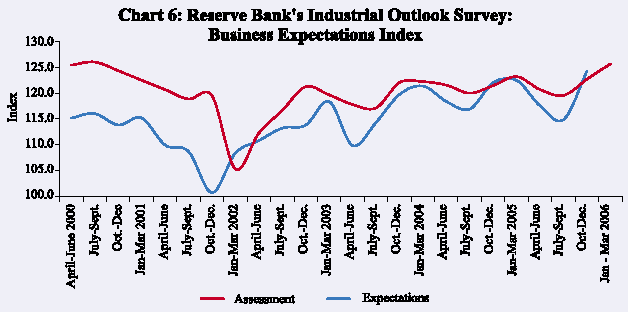
|
Table 8: Net Response on ‘A Quarter Ahead’ Expectations about Industrial Performance |
|||||||
|
(Per cent) |
|||||||
|
Jan- |
Apr- |
July- |
Oct- |
Jan- |
|||
|
Parameter |
Response |
March |
June |
Sept. |
Dec. |
March |
|
|
2005 |
2005 |
2005 |
2005 |
2006 |
|||
|
(987) |
(987) |
(816) |
(961) |
(934) |
|||
|
1 |
2 |
3 |
4 |
5 |
6 |
7 |
|
|
1 |
Overall business situation |
Better |
47.4 |
44.3 |
45.5 |
51.3 |
49.8 |
|
2 |
Financial situation |
Better |
37.5 |
36.7 |
36.7 |
42.3 |
40.7 |
|
3 |
Working capital finance |
Increase |
29.2 |
27.2 |
28.8 |
32.7 |
31.9 |
|
requirement |
|||||||
|
4 |
Availability of finance |
Improve |
31.3 |
30.8 |
30.7 |
34.1 |
34.1 |
|
5 |
Production |
Increase |
45.9 |
38.7 |
40.7 |
46.9 |
46.3 |
|
6 |
Order books |
Increase |
42.2 |
37.4 |
39.6 |
43.7 |
41.0 |
|
7 |
Cost of raw material |
Decrease |
-41.8 |
-36.7 |
-43.6 |
-30.0 |
-35.9 |
|
8 |
Inventory of raw material |
Below average |
-7.4 |
-4.3 |
-4.2 |
-6.9 |
-6.8 |
|
9 |
Inventory of finished goods |
Below average |
-5.2 |
-3.1 |
-4.2 |
-3.3 |
-4.7 |
|
10 |
Capacity utilisation |
Increase |
31.3 |
27.7 |
25.4 |
31.1 |
29.6 |
|
11 |
Level of capacity utilisation |
Above normal |
12.9 |
8.1 |
7.6 |
10.9 |
11.4 |
|
12 |
Assessment of the |
More than adequate |
6.6 |
5.7 |
5.3 |
5.0 |
4.9 |
|
production capacity |
|||||||
|
13 |
Employment in the company |
Increase |
8.0 |
7.7 |
7.8 |
12.7 |
13.3 |
|
14 |
Exports, if applicable |
Increase |
31.5 |
30.2 |
32.5 |
33.3 |
31.8 |
|
15 |
Imports, if any |
Increase |
22.2 |
20.3 |
23.7 |
19.2 |
20.8 |
|
16 |
Selling prices are expected to |
Increase |
8.6 |
11.0 |
13.3 |
7.8 |
10.8 |
|
17 |
If increase expected |
Increase at lower rate |
8.2 |
13.5 |
14.0 |
16.6 |
16.3 |
|
in selling prices |
|||||||
|
18 |
Profit margin |
Increase |
5.6 |
6.3 |
7.1 |
9.6 |
12.6 |
|
Note : 1.
Figures in parentheses represent number of companies covered in the Survey. |
|||||||
financial situation, production, order books, capacity utilisation, and exports are expected to show some decline over the previous quarter. However, the expectations of all these indicators for January-March 2006 are better than that in the corresponding quarter of 2005 (Table 8).
Services Sector
Services sector growth accelerated to 9.8 per cent during the second quarter of 2005-06 from 9.6 per cent in the previous quarter and 7.7 per cent a year ago, led by its major constituent sectors (Chart 7 and Table 1).
Construction activity was buoyed up by rise in demand for housing. Rise in domestic and international tourism, both business as well as leisure, aided growth of the hotel industry. Higher revenue earning freight traffic of railways, civil aviation and port traffic reflecting increased economic activity propped up the transport sector. Robust growth in the cellular subscriber base and steady growth in
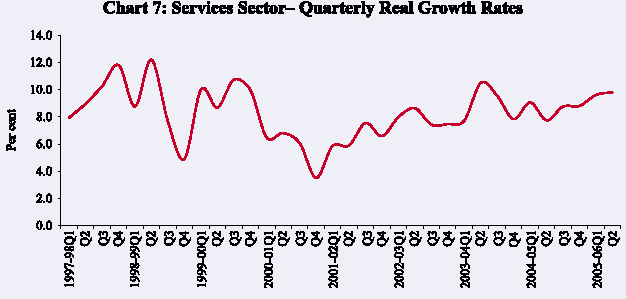
broadband connections supported the strong growth in the communication sector. Sustained growth in bank deposits and non-food credit as well as increased exports of information technology enabled services boosted the sub-sector ‘financing, insurance, real estate and business services’. Community, social and personal services increased due to increase in revenue expenditure on ‘other economic services’, ‘defence revenue expenditure’, plan revenue expenditure of the Central Government on ‘social services’, and pension payments. Latest available information on the major indicators of services sector indicates continued buoyancy in 2005-06 (Table 9).
|
Table 9: Indicators of Service Sector Activity |
||
|
(Growth rates in per cent) |
||
|
Sub-sector |
April-October 2004 |
April-October 2005 |
|
1 |
2 |
3 |
|
Tourist arrivals |
24.8 |
12.7 |
|
Commercial vehicles production (April-November) |
30.3 |
15.3 |
|
Railway revenue earning freight traffic |
7.7 |
9.5 |
|
New cell phone connections |
29.6 |
38.4 |
|
Cargo handled at major ports |
10.7 |
11.7 |
|
Civil aviation |
||
|
a) Export cargo handled |
11.9 |
15.5 |
|
b) Import cargo handled |
32.5 |
12.3 |
|
c) Passengers handled at international terminals |
15.3 |
12.8 |
|
d) Passengers handled at domestic terminals |
25.1 |
22.5 |
|
Roads: Upgradation of Highways |
4.6 |
-5.9 |
|
Cement (April-November) |
6.7 |
10.6 |
|
Steel (April-November) |
8.0 |
7.2 |
|
Aggregate deposits (April-December) |
7.5 |
14.0 |
|
Non-food credit (April-December) |
18.2 |
22.3 |
|
Central Government expenditure (April-November) |
-5.6 |
10.8 |
The normal South-West monsoon, the sustained growth of the manufacturing, the buoyancy in services and the positive business confidence and expectations have further brightened growth prospects for 2005-06 (Table 10).
|
Table 10: Projections of Real Gross Domestic Product for India by Various Agencies: 2005-06 |
||||||
|
Agency |
Growth Projections for 2005-06 (Per cent) |
Month of Projections |
||||
|
Overall Growth |
Agriculture |
Industry |
Services |
|||
|
1 |
2 |
3 |
4 |
5 |
6 |
|
|
ADB |
6.9 |
4.4 |
6.7 |
7.7 |
September, 2005 |
|
|
BIS |
7.1 |
June, 2005 |
||||
|
CII |
a) |
7.2 |
3.0 |
8.1 |
8.3 |
May, 2005 |
|
b) |
7.3 |
3.2 |
October, 2005 |
|||
|
CMIE |
a) |
6.0 |
(-)0.7 |
8.5 |
7.5 |
June 2005 |
|
b) |
6.8 |
3.0 |
8.5 |
7.5 |
August, 2005 |
|
|
c) |
7.6 |
3.0 |
8.1 |
9.2 |
December, 2005 |
|
|
CRISIL |
a) |
7.0 |
3.0 |
7.0 |
8.6 |
May, 2005 |
|
b) |
7.0 |
2.5 |
7.4 |
8.5 |
September, 2005 |
|
|
NCAER |
a) |
7.2 |
3.30 |
7.61 |
8.55 |
May, 2005 |
|
b) |
7.05-7.1 |
2.5 |
7.54 |
8.55 |
July, 2005 |
|
|
c) |
7.6 |
3.4 |
8.0 |
9.0 |
November, 2005 |
|
|
IMF |
a) |
6.7 |
April, 2005 |
|||
|
b) |
7.1 |
September, 2005 |
||||
|
Ministry of |
a) |
7.0 |
3.0 |
Expected |
Expected |
May, 2005 |
|
Finance |
to perform |
to perform |
||||
|
well |
well |
|||||
|
b) |
Over 7.0 |
3.0-3.5 |
8.5-10.0 per cent growth in |
December, 2005 |
||
|
industrial and services sectors |
||||||
|
Reserve |
a) |
Around 7.0 |
Growth in agriculture around 3.0 per cent; industry and |
April, 2005 |
||
|
Bank of |
services expected to maintain their current growth |
|||||
|
momentum |
||||||
|
b) |
7.0-7.5 |
Pick-up in agricultural output and in the momentum in |
October, 2005 |
|||
|
industrial and services sectors |
||||||
கடைசியாக புதுப்பிக்கப்பட்ட பக்கம்:

















